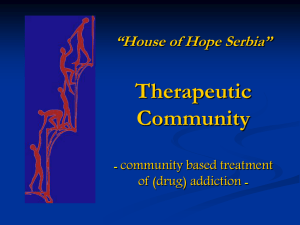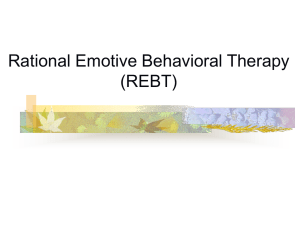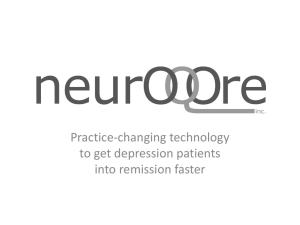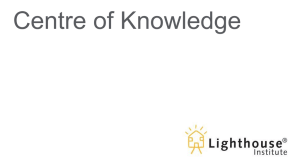THERAPEUTIC AGENTS
advertisement
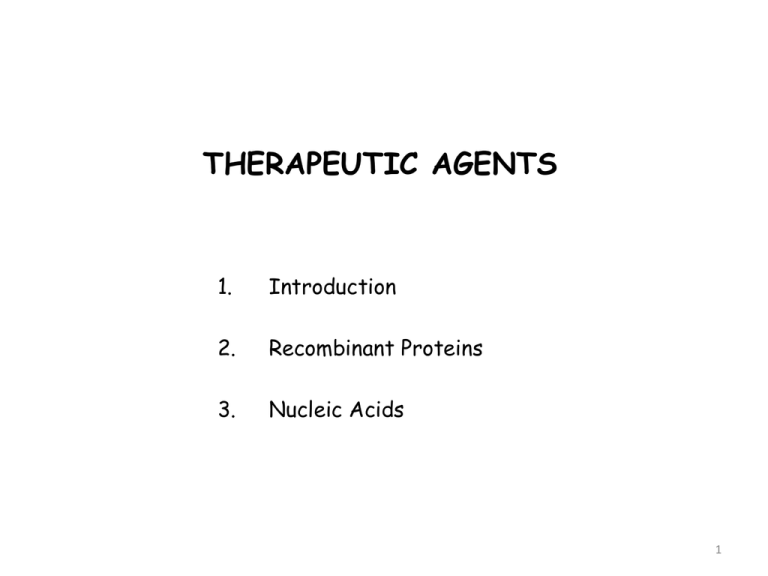
THERAPEUTIC AGENTS 1. Introduction 2. Recombinant Proteins 3. Nucleic Acids 1 Therapeutic Agents Introduction • Before the advent of molecular biotechnology most human proteins were available in only small (limited) quantities. Today hundreds of genes (~1000) for human proteins have been cloned, sequenced, expressed in the host cells and are being tested as therapeutic agents (drugs) in humans. • Over 140 biopharmaceuticals on the market; over 400 in clinical trials • Biopharmaceuticals include: – Proteins (made in bacterial, fungal or mammalian cell culture) • • • • • • • erythropoietin (EPO) insulin interferon (Intron A) granulocyte-colony stimulating factor (G-CSF) human growth hormone (HGH, human somatotropin) tissue plasminogen activator (tPA) – Monoclonal antibodies (made in mammalian cell culture) – Vaccines • live and inactivated viruses and bacteria • subunit vaccines • recombinant vaccines – Gene Therapy Products (viral and non-viral) 2 Therapeutic Agents Introduction Process of Drug Production Transfection Cell culture Purification Formulation/ Filling + Cells and plasmid Cell line Cell line manufacture Medium development Drug substance (crude) Bioreactor process development & scale-up Analytical characterization Drug substance (pure) Drug product (sterile) Downstream purification 3 Therapeutic Agents Introduction Development of the Process Biological Assay Development and Support Cell Line/ Viral Vector/ Construction Cell/Virus Culture Development/ Media Optimization Purification Process Dev. Formulation Design/ Drug Delivery Design Facility/Equipment Design Technology Transfer Process Validation Pilot-Scale cGMP Production Commercial-Scale Production 4 Therapeutic Agents Recombinant Proteins Human Interferons -> to fight viral infections -> Scientists discovered an antiviral protein in 1957 that inhibited growth of influenza virus in chicken embryos. It was named interferon because it interfered with the growth of influenza virus. • Anti viral proteins released by host cells (part of the immune system) • Interfere with viral multiplication • Host cell specific but not virus specific • Different types of cells in animals produce different interferons 5 Therapeutic Agents Recombinant Proteins Human Interferons -> to fight viral infections • 3 types of human interferon: – – – • alpha interferon (13 genes) beta interferon (2 genes) gamma interferon (1 gene) Alpha & beta usually produced early in viral infections (viruses or viral RNA) - Gamma appears later -> Presence of double-stranded RNA indicates cell is infected -> Viral infected cells release alpha and beta interferons Diffuse to neighboring cells -> Virus can’t replicate 6 Therapeutic Agents Recombinant Proteins Human Interferons -> to fight viral infections Antiviral Treatment: • Interferon therapy – Limited lifetime, short lasting effect – Recombinant interferons • Pure and fast • Hybrid genes for enhanced/new activity – Oral administration 7 Therapeutic Agents Recombinant Proteins Human Interferons -> to fight viral infections Why are Side Effects Common and Severe for Injectable Interferon? • • • Injectable interferon (beta) is approved world-wide (FDA) for the treatment of various cancers and viral diseases. Interferon is a protein readily eliminated from the blood by the kidney. To counteract the kidney’s clearance of interferon from the blood injectable interferon must be given in doses much higher than what occur naturally. Side effects include flu-like symptoms, poor results on liver function tests, and blood cell abnormalities. More serious side effects include depression, epileptic seizures, or liver problems. Why is Oral Interferon Different? • • • • Low-dose oral interferon is given in doses 10 thousand times less than injectable interferon. Therefore, side effects are dramatically reduced. Oral interferon is human interferon alpha administered in a small tablet (lozenge) to humans or in powder to animals. Oral interferon binds to surface (mucosal) cells in the mouth and throat resulting in stimulation of white blood cells and activates hundreds of genes affecting the immune system in the peripheral blood of man, cattle and mice. Studies show oral interferon is effective against disorders such as cancer, viral diseases and autoimmunity. 8 Therapeutic Agents Recombinant Proteins Human Interferons -> to fight viral infections Mechanism of Action Oral Epithelial Cells Tonsil IFNa Mandibular Lymph Nodes Activation of Humoral Immunity (Antibody) Activation of Perioral Lymphoid Cells and Peripheral Lymphoid Tissues Virus Activation of Cell Mediated Immunity Interferon placed in the mouth binds to receptors in the mucosal lining and initiates systemic effects on the immune system in animals and man. These immunomodulatory effects are safe and effective in helping control viral and autoimmune diseases and cancer. 9 Therapeutic Agents Recombinant Proteins Human Interferons -> to fight viral infections Manufacturing Steps for Interferon: 10 Therapeutic Agents Recombinant Proteins Human Interferons -> to fight viral infections Human diseases in which oral interferon has been tested and reported to be safe Behcet's disease Sjogren's syndrome Idiopathic pulmonary fibrosis Multiple sclerosis Aphthous stomatitis Oral mucositis - cancer Lichen planus Opportunistic infections - HIV+ Chronic active hepatitis B Chronic hepatitis C Wasting cancer patients Fibromyalgia Measles Respiratory syncytial virus Influenza Cough (COPD & IPF) 11 Therapeutic Agents Recombinant Proteins Human Interferons -> to fight viral infections Human Study – Influenza and Interferon • 14,000 people participated in controlled studies of placebo versus interferon treatment during a natural outbreak of Hong Kong influenza. • Interferon (about 128 units) or placebo was dripped into the nose daily for 5 days starting about the time of the first reported influenza cases. • Interferon significantly (P<0.01) reduced the number of influenza cases. Percent of Patients Sick Efficacy of Human Leukocyte Interferon as Prophylaxis Against Influenza 25 20 15 Interferon 10 Placebo 5 0 Adults Children 7-12 yr Population (14,000 subjects total) Children 2-6 yr Soloviev, Bull. WHO 41:683-688, 1969. 12 Therapeutic Agents Recombinant Proteins Strategies for Optimisation of Recombinant Production • Screening libraries of recombinant genes (IFNs, human growth hormone, TNF-a…) • Screening of recombinant expression systems (E coli, fungi, Mammalian cells…) • Delivery by intestinal bacteria (lactobacilli) 13 Therapeutic Agents Recombinant Proteins Enzymes – Treating Cystic Fibrosis • • • • Cystic fibrosis (CF) -> ~30,000 cases in the US and 23,000 in Canada. Europe: it occurs in 1 in 2,500 live birth and 1 in 25 are carriers. Caused by more than 500 different mutations in the cystic fibrosis transmembrane conductance regulator (CFTR) gene. Individuals with CF are highly susceptible to bacterial infection and antibiotic treatment often results in resistant strains. Symptoms: -> small ducts (special channels) become clogged with a thick mucus • Clogging and infection of lungs • plugging of small bile ducts in liver (impedes digestion) • plugging of ducts of pancreas (impedes digestion) • obstruction of small intestine • males are infertile • malfunctioning sweat glands 14 Therapeutic Agents Recombinant Proteins Enzymes – Treating Cystic Fibrosis Gene responsible for disease: CF is mostly caused by a 3 base pair deletion in Cystic Fibrosis Transmembrane Regulator (CTFR) -> F508 deleted CTFR -> ABC transporter coupled to a channel 15 Therapeutic Agents Recombinant Proteins Enzymes – Treating Cystic Fibrosis -> It transports Cl- ions after being phosphorylated and binding two ATP molecules -> It has a large regulatory domain that is phosphorylated by a cAMP dependent protein kinase 16 Therapeutic Agents Recombinant Proteins Enzymes – Treating Cystic Fibrosis A normal lung Chloride into airway; sodium out - keeps mucus moist and thin Normal CFTR regulates the sodium channel (inactivates it) A CF lung Chloride does not get into airway; more sodium leaves; More salt in cell -> water comes in ->This makes the mucus thick 17 Therapeutic Agents Recombinant Proteins Enzymes – Treating Cystic Fibrosis Treatments: • Chloride delivery - activate other chloride carriers • Viscous mucus - pounding, DNase treatment, gelosin • recurrent infections – antibiotics • tissue damage due to immune response - anti-inflammatory drugs (ibuprofen) 18 Therapeutic Agents Recombinant Proteins Enzymes – Treating Cystic Fibrosis DNase 1 (GeneTech) • A thick mucus which is a results of: – – – • • • • Alignate produced by bacteria DNA from lysed cells Leucocytes which accumulate due to the infection Makes breathing difficult. Scientist at Genentech isolated the gene for DNase1 The purified enzyme was delivered as an aerosol to the lung where it hydrolysed the DNA into short oligonucleotides. This decrease the viscosity in the lungs and made breathing easier. Alginate Lyase • • • • Alginate is a polysaccharide polymer that is produced by bacteria. The excretion of alginate by Pseudomonas aeruginosa of patients with CF contributes to the viscosity in the lung. The enzyme alginate lyase can liquefy bacteria alginate. Alginate lyase was isolate from Flavobacterium sp. and cloned into E. coli. -> Combined with DNase1, alginate lyse is able to reduce the mucus in the lungs of patients with CF. 19 Therapeutic Agents Recombinant Proteins Monoclonal Antibodies Clinical Applications • Transplantation – muronomab (OKT3) 1986, basiliximab 1998 • Cardiovascular disease – abciximab 1994 • Cancer – rituximab 1997, trastuzumab 1998 • Viral infection – palivizumab 1998 • Inflammatory diseases – infliximab 1998, etanercept 1999 Side effects: • Transfusion reactions (any adverse event which occurs because of a blood • • • Infections, immunosuppression Cardiac, respiratory arrest (discontinuation of breathing) Pharmacological toxicity transfusion) 20 Therapeutic Agents Recombinant Proteins Monoclonal Antibodies Production • • • • • • • Monoclonal antibodies results from a clone of a B lymphocyte producing a single antibody which will bind to a specific epitope of an antigen. Monoclonal antibodies are produced: – Fusion of a myeloma (B cell which has become cancerous) with a spleen cell that is immunized with a specific antigen. The resulting hybridomas are tested for the production of a monoclonal antibodies. Diluted to one cell cultures Hypoxanthine Guanine Phosphoribosyl Transferase (HGPT) negative myeloma cells Grown in Hypoxanthine Aminopterin Thymidine (HAT) medium Only successful fusion cells grow (rare) 21 Therapeutic Agents Recombinant Proteins Production: Monoclonal Antibodies Major Problems with non-human ABs: Immunological Responses ”Humanization” of ABs 22 Therapeutic Agents Recombinant Proteins Monoclonal Antibodies Chimeric Ab Humanized Ab DNA that encodes the binding portion of monoclonal mouse antibodies and merges it with human antibody-producing DNA. 65 – 90% human and consist of the mouse variable regions and substituting the mouse Fc region of the antibody with that from human 95% human, and are made by grafting the hypervariable region (or CDR) of the chimeric antibody –which determines Ab specificity Use mammalian cell cultures to express this DNA and produce these half-mouse and half-human antibodies. (Bacteria cannot be used for this purpose, since they cannot produce this kind of glycoprotein.) Depending on how big a part of the mouse antibody is used, one talks about chimeric antibodies or humanized antibodies. 23 Therapeutic Agents Recombinant Proteins Antibodies for human therapy derived without using mice: -> uses various "display" methods (primarily phage display) as well as methods that exploit the elevated Bcell levels that occur during a human immune response. • Create new variations of antibodies – • • • New combinations of heavy and light chains mRNA from immunized individual PCR H and L chains Clone into vector in new H/L combinations -> create library -> screening by display 24 Therapeutic Agents Recombinant Proteins Antibodies for human therapy derived without using mice: Screening by Phage display 25 Therapeutic Agents Recombinant Proteins Antibodies for human therapy derived without using mice: Single-chain Fixed variable only one heavy-chain variable domain and one light-chain variable domain covalently linked by peptide Single-Chain Combinatorial Antibody Library 26 Therapeutic Agents Recombinant Proteins Monoclonal Antibodies Application of single-chain fixed variable-> Immunotoxins • • • Protein toxin connected to Fv region Single-chain or S-S linked Fv region Toxin localized to antigen-expressing cells 27 Therapeutic Agents Recombinant Proteins Monoclonal Antibodies Examples: Monoclonal antibodies for cancer. ADEPT, antibody directed enzyme prodrug therapy; ADCC, antibody dependent cell-mediated cytotoxicity; CDC, complement dependent cytotoxicity; MAb, monoclonal antibody; scFv, single-chain Fv fragment 28 Therapeutic Agents Recombinant Proteins Monoclonal Antibodies Examples: Target Angiogenesis -> to prevent tumor growth Dr. Judah Folkman (1971) Tumor secretes factors -> promote blood vessel growth to the tumor 29 Therapeutic Agents Recombinant Proteins Examples: Monoclonal Antibodies Target Angiogenesis -> to prevent tumor growth • Bevacizumab (Avastin®) Recombinant humanised monoclonal antibody target ing the angiogenic factor VEGF (93% human, 7% mouse) 30 Therapeutic Agents Nucleic Acids As Therapeutic agents • Many human disorders e.g. cancer and inflammatory conditions (virus, parasites) are often caused by overproduction of a normal protein. • Theoretically a small ss nucleic acid can hybridize to a specific gene or mRNA and diminish transcription or translation. (antisense RNA) An oligonucleotide (oligo) that binds to a gene and blocks transcription is an antigene. An oligo that binds to mRNA and blocks translation is called an antisense oligo or antisense RNA. Ribozyme (catalytic RNA) and interfering RNA ( RNAi) can target specific mRNA for degradation. • • • 31 Therapeutic Agents Nucleic Acids Antisense RNAs • Gene segment cloned into expression vector in reverse orientation • Formation of dsRNA can interfere with RNA processing or translation 32 Therapeutic Agents Nucleic Acids Antisense RNAs -> Applications • • • • Episomally based expression vectors with cDNA for insulin-like growth factor 1 (ILGF-1) receptors were constructed in the antisense version. ILGF-1 is prevalent in malignant glioma a common form of brain cancer and prostate carcinoma. Culture of glioma cells when transfected with the antisense version of ILGF-1 in ZnSO4 lost its tumurous properties. A similar treatment of mice which were injected with prostate carcinoma cells caused small or no tumor to develop. 33 Therapeutic Agents Nucleic Acids Antisense Oligonucleotides • • • • Antisense deoxynucleotides can also be used as therapeutic agents. However when injected into the body is deoxynucleotides are susceptible to degradation. To prevent this modified deoxynucleotides are used including phosphorothioate, phosphoramidate and polyamide. Free oligos are usually introduced into to the body encapsulated in a liposome. Phosphodiester linkage Phosphorothioate linkage Phosphoramidite linkage Polyamide linkage 34 Therapeutic Agents Nucleic Acids Antisense Oligonucleotides • • • • Antisense deoxynucleotides can also be used as therapeutic agents. However when injected into the body is deoxynucleotides are susceptible to degradation. To prevent this modified deoxynucleotides are used including phosphorothioate, phosphoramidate and polyamide. Free oligos are usually introduced into to the body encapsulated in a liposome. Liposome Delivery of Therapeutic Nucleic Acids: • • • Small vesicles of phospholipid bilayer Fuse to cells and release contents into cytoplasm Approach can target human cells and/or infectious agent in early stage tests (e.g. mycobacterium tuberculosis) 35 Therapeutic Agents Nucleic Acids Antisense Oligonucleotides Treatment of Psoriasis: • • • • Psoriasis is uncontrollable epidermal growth. ILGF-1 receptors are implicated (upregulated) in the pathogenesis of psoriasis. 15 nt antisense oligo were transferred into keratinocytes using liposome and the amount of ILGF-1 protein was decreased by 45-65%. When mouse with human psoriasis lesions were injected with anitsense oligi complementary to ILGF-1 receptor mRNA there was significant reduction (58-69%) in epidermal thickness. Correct Mutation in Splice Site in beta-globin gene (Thalassemia): • Synthetic oligonucleotide blocks site of mutation which created mutant “alternative” splice junction – Acts at RNA level 36 Therapeutic Agents Nucleic Acids RNA Interference (RNAi) • • • • • • • RNA interference or gene silencing dsRNA processed by nucleases into small segments then target RNase to complementary RNA molecules Works well in plants and many animals -> Not humans Gene silencing has been shown to be a natural mechanism which plant and animals use to protect against viruses. The dsRNA that is introduced is cleaved by dsRNAse into ssRNA of 21-23 nt. These short oligos complex with RISC ( RNA inference inducing silencing complex) which degrade the mRNA complimentary to the oligos. This process can be used to target specific mRNA. 37 Therapeutic Agents Nucleic Acids RNA Interference (RNAi) As Therapeutic Agents: • • • A viral vector used to deliver a small fragment of RNA to brain cells of mice with SCA1 (human neurodegenerative disease spinocerebellar ataxia 1). This suppress the SCA1 gene and the mice has normal coordination and movement. Scientists are optimistic about using RNAi to treat other neurological diseases such as Alzheimer’s and Hunting’s disease. 38 Therapeutic Agents Nucleic Acid Gene Therapy – Clinical Trials (1990-1999) 39 Therapeutic Agents Nucleic Acid Gene Therapy – Principle • • • • Cells of tumor often interconnected by cytoplasmic bridges and pores Introduce expression vector into some tumor cells Gene expressed converts prodrug into lethal compound “Shared” with other interconnected tumor cells 40 Therapeutic Agents Nucleic Acid Gene Therapy – Prodrug Activation Systems 41

